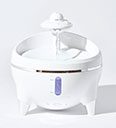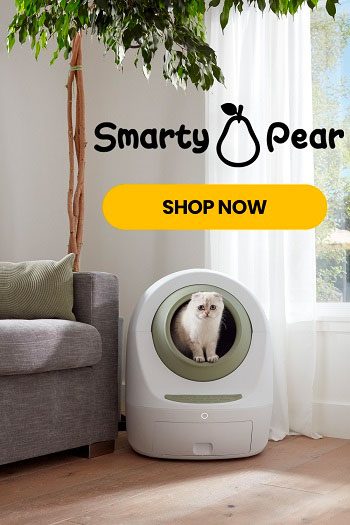Does your cat eagerly wolf down their food, but then turn up their nose at their water bowl, leaving you worried about their lack of water consumption? We all know that water is essential for our feline's well-being, but sometimes convincing them to increase their water intake can feel like a never-ending challenge.
This article will guide you through various ways to encourage your cat to drink enough water for good health.
Reasons Why Your Cat Doesn't Drink Enough Water
Some cats are picky and only want to drink from a certain type of cat bowl
Cats can be quite discerning when it comes to their water bowls. Some may have specific preferences for the material, shape or depth of their water dish. Observing your cat's behavior and experimenting with different types of bowls can help you identify their preferences. Providing them with a water bowl that suits their preferences may encourage them to drink more water.
Cats may not drink enough if they're eating mostly dry food
Cats that consume predominantly dry food may not feel the same level of thirst as those on a wet food diet. Dry food contains less moisture compared to wet food, which can lead to lower water intake. If your cat primarily eats dry food, it's essential to actively encourage them to drink water by implementing some of the previously mentioned strategies, such as using a water fountain or adding moisture to their diet.
Cats may be getting enough water from their wet food, but it's important to still provide fresh water
While wet food contains a higher water content, it's important to remember that cats still require access to fresh water. Even if your cat consumes wet food, providing a separate bowl of fresh water is necessary. It ensures they have a continuous supply of clean water to meet their hydration needs throughout the day.
How Can I Encourage My Cat To Drink More Water?
Provide fresh water supply in a clean bowl
To ensure your cat stays properly hydrated, the most basic step is to offer them a fresh, clean bowl of water. Cats are known for their cleanliness, so a dirty water bowl may deter them from drinking enough water.
If your cat shares a water bowl with other pets, you should ensure that the water stays clean throughout the day as much as possible.
Regularly wash the water bowl with mild soap and water, and refill it with fresh water at least once or twice a day.
Consider a water fountain or other water source that allows for running water
Many cats are attracted to the sight and sound of running water. Consider investing in a cat water fountain or another water source that provides a continuous flow of water. The movement can be enticing for your feline friend and encourage them to drink more water throughout the day.
Try offering bottled or filtered water if your cat doesn't like tap water
Some cats may be sensitive to the taste or smell of tap water. If you notice that your cat is reluctant to drink from the tap, you can try offering them bottled water or filtered water.
This can help eliminate any impurities or odors that may be off-putting to your cat, making the water more appealing.
Feed your cat wet food
One effective way to increase your cat's water intake is by incorporating wet food into their diet. Wet food has a higher water content, providing your cat with an additional source of hydration.
Consider including a portion of wet food in your cat's daily meals to help them stay properly hydrated.
Try adding a small amount of tuna juice or low-sodium chicken broth to your cat's water
When a particularly finicky cat is not drinking water, you can try adding a small amount of tuna juice or low-sodium chicken broth. The enticing aroma and flavor can pique their interest and encourage them to drink more.
However, it's important to use these additives sparingly and ensure they are safe for feline consumption.
Why Is It Important for Cats To Drink Enough Water?
Cats need water to stay healthy and hydrated
Just like humans, cats depend on water to support various bodily functions. Adequate hydration helps maintain healthy organ function, aids in regulating body temperature and facilitates nutrient absorption.
Cats may become dehydrated quickly
Unlike some other animals, cats have a naturally low thirst drive, which makes them prone to dehydration. In cats, dehydration can occur swiftly and may lead to serious health issues if left unaddressed.
The right amount of water can prevent urinary tract infections
Insufficient water intake can contribute to the development of urinary tract infections (UTIs) in cats. Water helps flush out toxins and bacteria from the urinary system, reducing the risk of UTIs. By ensuring your cat drinks enough water, you're promoting a healthy urinary tract and minimizing the likelihood of such infections.
Cats need water for digestion and to prevent constipation
Adequate water intake is essential for proper digestion and to prevent constipation in cats. Water helps break down food, aids in the absorption of nutrients and promotes healthy bowel movements.
Without sufficient water, cats may experience digestive issues, including constipation, which can be uncomfortable and potentially harmful.
Many canned cat foods contain a lot of water, so it's important to make sure they're also drinking water
Canned cat foods often have a higher water content compared to dry food. While these moist foods can contribute to your cat's water intake, it's important to note that they shouldn't solely rely on them for hydration.
Encouraging your cat to drink water in addition to consuming canned food ensures they receive an adequate amount of water to support their overall health.
What Are the Signs of Dehydration in Cats?
Dry mouth and nose
One of the primary signs that your cat is dehydrated is a dry mouth and nose. Normally, a well-hydrated cat will have a moist mouth and a cool, slightly damp nose.
If you notice that your cat's mouth and nose appear dry, it may indicate that they are not drinking enough water.
Loss of appetite
Dehydration can lead to a loss of appetite in cats. If your cat suddenly shows a decreased interest in food or completely stops eating, it could be a sign that they are dehydrated. Proper hydration is essential for maintaining a healthy appetite, so changes in eating behavior should be monitored closely.
Lethargy and lack of energy
Dehydrated cats often exhibit lethargy and a lack of energy. They may seem unusually tired, inactive or uninterested in their usual activities. If your cat appears less playful or shows a significant decrease in energy levels, it could be a red flag for dehydration.
Panting or breathing with an open mouth
Cats typically don't pant like dogs do, so if you notice your cat panting or breathing heavily with an open mouth, it could be a sign of dehydration. Panting in cats is not a normal behavior and may indicate that they are overheating and trying to cool down due to inadequate hydration.
Loss of skin elasticity
To check for dehydration, gently lift the skin on the back of your cat's neck and then release it. In well-hydrated cats, the skin will quickly return to its normal position. However, dehydrated cats may have decreased skin elasticity, causing the skin to return slowly or remain slightly tented. This test can be a useful indicator of hydration levels in your cat.
Exactly How Much Water Should My Cat Drink Daily?
The daily water intake for cats can vary based on factors such as their size, age, activity level and overall health. As a general guideline, cats need to drink approximately 3.5 to 4.5 ounces of water per five pounds (2.3 kilograms) of body weight. However, it's important to remember that individual cats may have unique hydration needs.
Monitor your cat's drinking habits
To ensure your cat is adequately hydrated, it's crucial to monitor their drinking habits. Observe how much water they typically consume in a day and compare it to the recommended intake based on their body weight. If you notice a significant deviation or if you suspect they are not drinking enough water, it's advisable to consult with your veterinarian for further guidance.
Conclusion
By providing fresh water, considering alternative water sources like fountains and offering wet food, you can encourage your cat to stay properly hydrated. Paying attention to signs of dehydration and understanding the importance of water in preventing health issues like UTIs and constipation is vital.
Remember, every cat is unique, so be patient and try different approaches to find what works best for yours. With your love and care, you can keep your cat's thirst quenched, their spirits high and their health flourishing.





